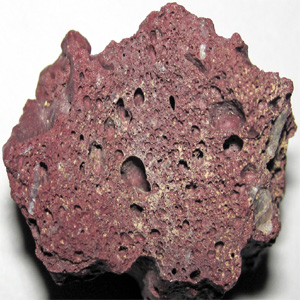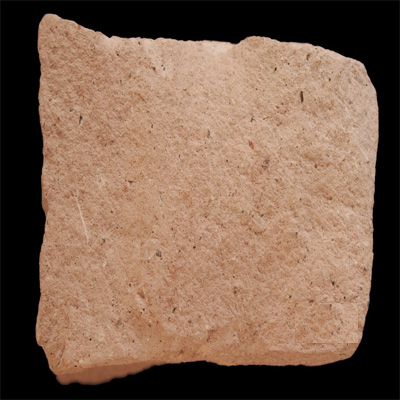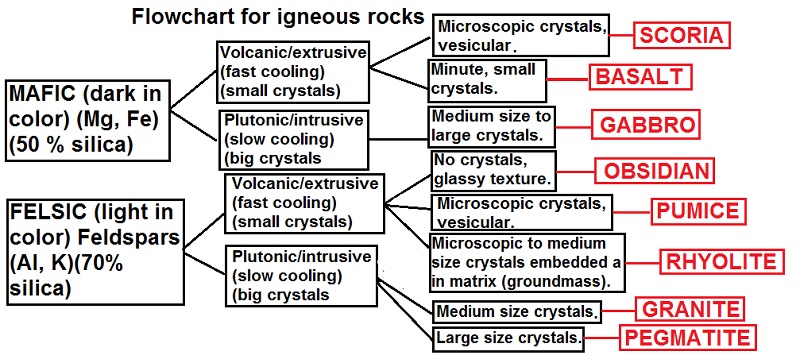IGNEOUS ROCKS
 |
|
|---|---|
 |
|
| Properties of Igneous Rocks - Examine the three rock specimens below. These specimens are examples of three types of igneous rocks: scoria, basalt, and gabbro. In certain ways these three rocks are very similar: they are all dark gray and are composed of essentially identical chemical components. This indicates that the basalt and the gabbro are made of the same minerals. The scoria is fine-grained or glassy and therefore contains no visible minerals. When minerals are present, they are the same ones as found in the basalt and gabbro. In other ways the specimens are different. Using the table below, briefly describe how these three rocks differ from each other. | |
 |  |
SCORIA | BASALT |
 |
|
| GABBRO |
|
 |
|
| How do the differences noted above in grain size and the presence of air pockets arise? | |
| ____________________________________________________________________ | |
| ____________________________________________________________________ | |
| Only two of these rock types are found in sills. Which are they and where are they located within the sill? Why? | |
| ____________________________________________________________________ | |
| ____________________________________________________________________ | |
| All three rock types may be found within the lava flow. Where would they be located within the flow? Why? | |
| ____________________________________________________________________ | |
| ____________________________________________________________________ | |
| In the Andes Mountains, large bodies of magma (molten rock) were intruded upward into older rocks and solidified to form formations called batholiths made of igneous rocks (see the figure below). In some places, the magma was forced into cracks and solidified to form cross-cutting bodies made of igneous rocks called dikes. Some of the cracks extend to the surface of the earth and molten rock made its way upward and was erupted at the surface as lava flows which solidified to form igneous rocks. | |
 |
|
| Examine the following specimens: pumice, obsidian, rhyolite, granite, and pegmatite. All these rocks are chemically similar. The pumice and obsidian are glasses and contain no minerals. The rhyolite, granite, and pegmatite contain minerals which are the same or similar. | |
 |  |
PUMICE | OBSIDIAN |
 |  |
RHYOLITE | GRANITE |
 |
|
| PEGMATITE |
|
| How do the pumice and obsidian differ from each other? | |
| ____________________________________________________________________ | |
| ____________________________________________________________________ | |
| How do the rhyolite, granite and pegmatite differ from each other in terms of grain size? | |
| ____________________________________________________________________ | |
| ____________________________________________________________________ | |
| How did the differences between these five specimens originate? | |
| ____________________________________________________________________ | |
| ____________________________________________________________________ | |
|
|
|
|
PUMICE - cooled down very fast from lava and has vesicles that indicate that gases were escaping from the rock - microscopic crystals. OBSIDIAN - also cooled down very fast from lava and that is why the glassy appearance with no crystals. RHYOLITE - is a mixture of crystals that were cooling down slowly inside the magma chamber and then a volcanic explosion carried them up to the surface embedded in a ground mass that cooled very quickly. GRANITE - cooled slowly inside the magma chamber relatively closer to the surface - medium size crystals. PEGMATITE - cooled at depth inside the magma chamber - large crystals. |
|
Igneous
rocks are divided into two groups: VOLCANIC (extrusive) and PLUTONIC
(intrusive).
|
|
VOLCANIC
or EXTRUSIVE igneous rocks come from solidified LAVA. Since LAVA COOLS
QUICKLY (outside the Earth's surface) crystals (grains) do not have
time to grow, therefore volcanic or extrusive igneous rocks have tiny,
sometimes microscopic crystals, or they don't have crystals at all.
|
|
PLUTONIC or INTRUSIVE igneous rocks come from solidified MAGMA. Since MAGMA COOLS SLOWLY (inside the Earth's surface) crystals (grains) have time to grow, therefore plutonic or intrusive igneous rocks have medium size to large crystals. |
|
In
addition, igneous rocks according to their chemical composition are subdivided
in to two main groups: MAFIC and FELSIC.
|
|
MAFIC
igneous rocks are DARK in color due to their chemical composition which
is about 50% silica, Mg (magnesium), Fe (iron) and Ni (nickel).
|
|
FELSIC
igneous rocks are LIGHT in color due to their chemical composition which
is about 70% silica, K (potassium), Al (aluminum) with abundant light
minerals (in color) like quartz and feldspar.
|
|
Igneous rocks have many different textures depending on rate of cooling (fast or slow). Igneous rocks can be: |
|
GLASSY
- looks like a glass and has no crystals (grains), rocks cooled very
fast.
|
|
VESICULAR
- has vesicles (air pockets) produced by escaping gases when the lava
reached the Earth's surface. Crystals are microscopic, rocks cooled
fast.
|
|
APHANITIC
- crystals are tiny, rock cooled fast from lava outside the Earth.
|
|
PORPHYRITIC
- mixture of embedded crystals in a fine groundmass. Cooled in two stages:
magma cools slowly forming medium to large crystals ad then those embedded
crystals mixed with Lava come in an explosion that cools very fast.
|
|
PHANERITIC
- medium size to large crystals that are cooled from magma inside the
Earth.
|
 |
Name of rock = SCORIA Type of rock = VOLCANIC/EXTRUSIVE Composition = MAFIC Cooling rate = FAST FROM LAVA Texture = VESICULAR |
 |
Name of rock = BASALT Type of rock = VOLCANIC/EXTRUSIVE Composition = MAFIC Cooling rate = FAST FROM LAVA Texture = APHANITIC (tiny Crystals) |
 |
Name of rock = GABBRO Type of rock = PLUTONIC/INTRUSIVE Composition = MAFIC Cooling rate = SLOW FROM MAGMA Texture = PHANERITIC (medium size crystals) |
 |
Name of rock = OBSIDIAN Type of rock = VOLCANIC/EXTRUSIVE Composition = FELSIC Cooling rate = FAST FROM LAVA Texture = GLASSY |
 |
Name of rock = PUMICE Type of rock = VOLCANIC/EXTRUSIVE Composition = FELSIC Cooling rate = FAST FROM LAVA Texture = VESICULAR |
 |
Name of rock = RHYOLITE Type of rock = VOLCANIC/EXTRUSIVE Composition = FELSIC Cooling rate = TWO STAGE COOLING: CRYSTALS COOLED SLOWLY AND THEY EMBEDDED IN LAVA EJECTED FROM A VOLCANO Texture = PORPHYRITIC (medium size crystals embedded in a fine groundmass) |
 |
Name of rock = GRANITE Type of rock = PLUTONIC/INTRUSIVE Composition = FELSIC Cooling rate = SLOW FROM MAGMA Texture = PHANERITIC (medium size crystals) |
 |
Name of rock = PEGMATITE Type of rock = PLUTONIC/INTRUSIVE Composition = FELSIC Cooling rate = SLOW FROM MAGMA Texture = PHANERITIC (large size crystals) |
|
|
|
|
Magmatic intrusions and lava flows - There are intrusions of magma associated with igneous rocks. Some of the intrusions shown above are SILLS and DIKES. |
|
|
LAVA FLOWS - igneous material erupted onto the Earth's surface. In a lava flow the top layer will consist of SCORIA (gases escaped easily - microscopic crystals), the middle layer will consist of BASALT (rock cooled closed to the surface - tiny crystals), and at the bottom of the intrusion eruption away from the surface GABBRO will form (rock cooled underground - large crystals). |
|
|
SILLS - are horizontal igneous intrusions that never reach the surface. Since these rocks cool underground, one can only find BASALT and GABBRO. BASALT will be cool closer to the Earth's surface and GABBRO will cool deep underground. |
|
|
DIKES - are vertical igneous intrusions that never reach the surface and also cool underground and there one can find only BASALT and GABBRO. |

©David Leveson and David Seidemann - Brooklyn College - Earth and Environmental Sciences

